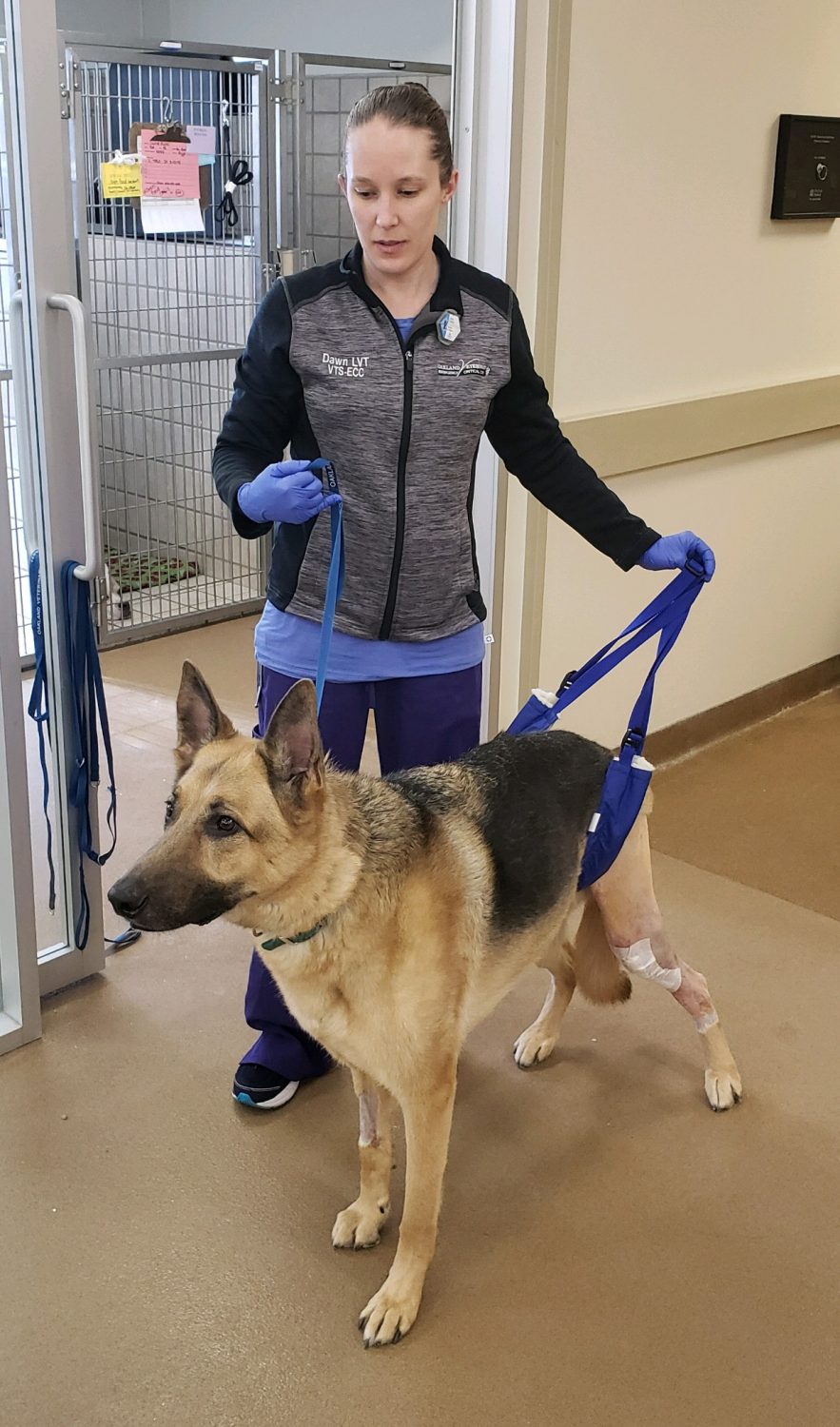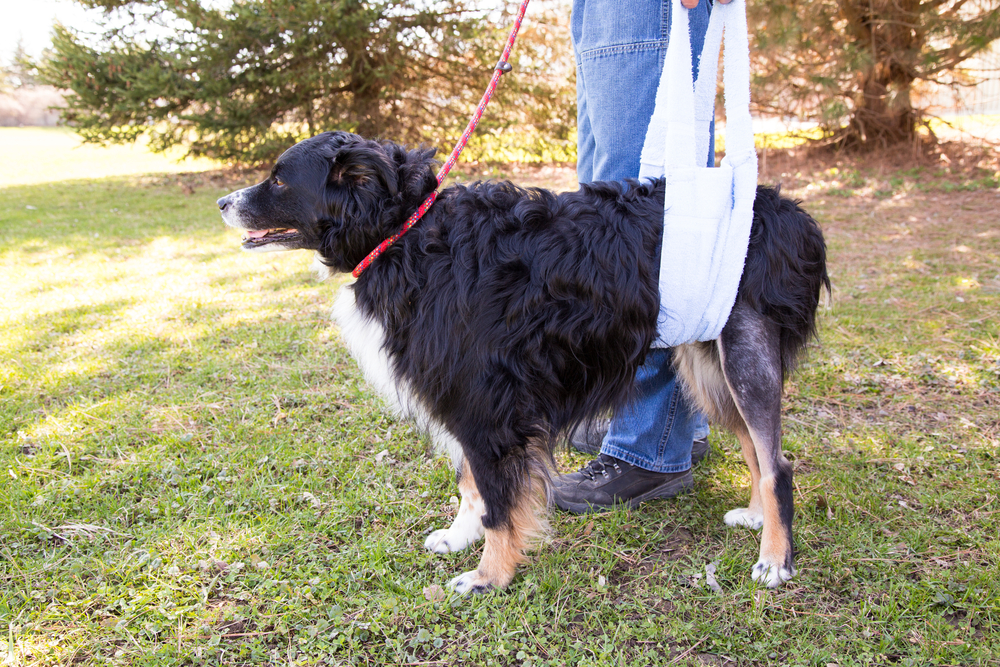What are the risks of surgery?
As with any surgery, there are always potential complications when performing surgery. Anesthetic complications are possible, so it is important to consider a patient’s overall health prior to proceeding with surgery. Blood-work is recommended prior to surgery to ensure appropriate kidney and liver function and to help screen for other diseases processes. Minor complications such as swelling, bruising, or seroma formation are possible following surgery, and are typically self-limiting and resolve within a few days of surgery.
Implant failure is extremely rare, but is the most catastrophic potential complication. Plates and screws used with the TPLO are very strong. However, in rare cases when pets are allowed too much activity very early on in the healing process, it’s possible for the plate to bend or for the screws to bend or break.
Infection occurs in approximately 5% of lateral sutures and 7% of TPLO’s. Some of these infections are limited to the skin, in which case a short course of antibiotics can successfully manage to problem. In other cases, bacteria can get onto the implant and a patient must be maintained on antibiotics until the bone has completely healed (12-16 weeks after surgery), at which point the plate may need to be removed. Implant (plate) associated infections can occur weeks, months, or even years following surgery. Approximately 3-5% of patients undergoing surgery will need to have the implant removed at some point in the future.
Meniscal injuries are possible with CrCLR. The meniscus contains nerve fibers, and thus patients with a meniscal tear may exhibit greater pain and lameness than patients without a meniscal tear. As previously mentioned, approximately 40% of patients with CrCLR will have a meniscal tear at the time of surgery. The longer the cruciate injury has been present and the greater the instability in the joint, the more likely a patient is to develop a meniscal injury. If the meniscus is torn at the time of surgery, the torn portion is removed. If the meniscus is intact, in most cases it will be left without any treatment as it serves important roles for joint health. There is evidence that dogs with meniscal injuries, and dogs in which a portion of the meniscus must be removed, have a faster progression of osteoarthritis. Luckily, arthritis alone is rarely a cause of significant pain and lameness in dogs, as long as the underlying disease process (cranial cruciate ligament injury) is treated. Approximately 10% of dogs that undergo surgery to repair a cruciate injury will at some point in time develop a meniscal tear. However, it’s much more likely that a persistently unstable joint will go on to develop a meniscal tear than one that has been surgically stabilized.
Does My Dog Need Surgery?
The choice to pursue surgical management is typically based on patient size, the stage of disease, the amount of instability present, the expectations you have for your pet’s activity level and quality of life, and the presence of any other concurrent medical conditions (severe heart disease, uncontrolled hormonal disease, cancer, etc). In some cases (patients with a very early partial tear of the cruciate ligament, obese patients, patients with minimal instability), medical management may be successful. However, surgical treatment for rupture of the cranial cruciate ligament carries the most predictable outcome for dogs over approximately 30 pounds.
An Overview of CCL Ruptures in Dogs and Cats
You may be familiar with an ACL tear in humans. A torn anterior cruciate ligament is quite common among athletes. Similarly, the cranial cruciate ligament (CCL) in pets can tear after extensive impact on the ligament or during a sudden injury.
There are two ligaments in a pet’s knee joint–the cranial cruciate ligament and the caudal cruciate ligament. These ligaments are responsible for helping the knee function as a hinge joint, and help to prevent rotation between the femur (upper bone) and tibia (lower bone, AKA shin bone). The meniscus helps to act as a cushion between the tibia and femur.
A torn CCL causes pain and immobility. The level of immobility depends on the severity of the rupture. The diagnosis relies on an examination, X-rays, and manipulating the joint (called the cranial drawer test). This test measures the level of instability present in the joint. Over time, the joint will continue to degenerate, resulting in pain, chronic arthritis and lameness.
To treat a CCL rupture, veterinarians recommend the Tibial Plateau Leveling Osteotomy (TPLO), Tibial Tuberosity Advancement (TTA), or Lateral Fabellotibial Suture (LFS) surgery. Because of the success rate of the TPLO procedure, it is the most popular type of repair. Your dog will have better mobility and reduced osteoarthritis after surgery.
The TPLO procedure is a method to repair a cruciate ligament rupture. TPLO surgery helps to stabilize the stifle and reduce the likelihood of further osteoarthritis progression. The TPLO is the most common procedure for dogs with a cruciate tear. It requires a specialty surgeon to perform this procedure.
Prior to the TPLO procedure, the surgical team uses carefully positioned digital x-rays to help plan the procedure. The surgeon will inspect the knee structures and remove remnants of the damaged ligament(s). They do this by either opening the joint to look inside, or by making a small incision to take a closer look arthroscopically, using a miniature camera.
During the surgery, the surgeon cuts the tibial plateau (the load bearing area of the knee) and repositions it in a 5 degree angle. The stifle (knee joint) will then be stable for the animal when bearing weight.
The surgeon performs the TPLO by cutting, rotating (to reduce excessive slope), and then repositioning the tibia. The bone graft is secured into place using a specially designed bone plate and screws.
The surgeon will also evaluate the meniscus. A torn meniscus can act as a source of constant irritation to the joint. The surgeon will remove any damaged parts of the meniscus. If the meniscus is not damaged, the surgeon performs a “meniscal release”. This helps prevent it from being damaged in the future.
After the procedure, X-rays will once again be ordered to determine the new angle of the shin and how the position of the screws/plates are functioning. A bandage is applied over the incision site for protection.
For most dogs, this surgery requires an overnight stay in the hospital. During the procedure, your pet will be under a general anesthesia. The hospital will also administer painkillers and antibiotics.
Because the TPLO procedure is a major orthopedic surgery, surgeons recommend it for dogs where not having the surgery will be worse for the pet’s health than having the surgery. In general, the TPLO has an excellent success rate. Deterioration of the ligaments and joints over time can be greater than the small risk associated with surgery. Your surgeon will discuss the best cruciate ligament surgery options for your dog on an individual basis.
The TPLO is more often suggested in injuries affecting large and giant dog breeds. But dogs of all breeds and ages may benefit from this procedure. Dogs that are good candidates for the surgery have experienced a rupture of the CCL and have joint instability with mild to severe lameness.
The recovery period following an extensive orthopedic surgery will require rehabilitation for the best outcome. You can anticipate that your dog will need rest and exercise restrictions for 8-12 weeks. This allows the incision and bone to heal and the knee function to return. Most dogs recover in about 8 weeks. This can vary from patient to patient, based on factors such as age and overall body fitness level.
When you return home with your dog, follow these instructions for a successful recovery:

It is also important to provide a calm environment at home. Limit disruptions and noise as much as possible, as increased levels of stress can impact your dog’s ability to heal.
Avoid:

At 2 weeks post operatively, you can gradually increase the length of your dog’s leash walks. By the 8th week, your dog should be able to take two 20-minute walks each day and perform basic daily living activities.
At 8-10 weeks post operatively, your surgeon will do recheck x-rays to assess bone healing. Your dog will be able to gradually resume normal activities. We recommend a rehabilitation program to optimize your dog’s recovery. The rehabilitation facility should have experience in postoperative recovery from orthopedic injuries such as the TPLO. Some dogs also experience good results through laser therapy and acupuncture treatments.
TPLO Chapter 2: Signs your dog may have a knee injury
A dogs cranial cruciate ligament (also called the CCL or cruciate ) works much the same as a humans ACL and helps your pups knee function correctly. If your dog has an injured cruciate, your Charlotte vet may recommend TPLO surgery to stabilize your dogs knee and allow pain-free movement.